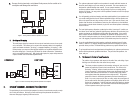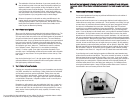V. PROTECTING YYOUR IINVESTMENT
A.
For full, year-after-year enjoyment from your speakers, you should respect their limits.
They will produce room-filling volume in average-sized rooms—and handle peak
momentary levels at those volumes without audible strain.
But aavoid llouder-tthan-llife
playback oof mmusic oor mmovies, eespecially iin llarge rrooms
. Even the most “bullet-proof”
speakers can be damaged by excessive volume levels, especially for long periods.
B. When llistening tto mmusic oor mmovies aat vvery lloud vvolume, yyou sshouldn’t tturn uup bbass oor
treble aall tthe wway oor cclose tthereto
. This sends tremendously increased, dispropor-
tionate power into the speakers, and may well damage them. Some loudness com-
pensation (“Loudness”) controls, which boost both bass and treble, can also be trou-
blesome at high volume. They are intended only for low-volume listening.
C. Finally, yyou sshould bbe aaware tthat wwhen aamplifiers aand rreceivers aare ppushed tto ttheir
limits tto pproduce eexcessive vvolume llevels, tthey aare ddriven iinto ““clipping” aand ccan ddo
severe ddamage—especially tto ttweeters
. Often, the damage is done by underpowered
amplifiers, which may reach their limits very soon. When such units begin to “clip”
the audio waveform, they may generate high-frequency “spikes” of tremendous
power. More tweeters have probably been destroyed by this phenomenon than any
other.
If uusing yyour sspeakers aat lloud llevels, llisten ccarefully ffor aany ssign oof hharsh, ggar-
bled mmidrange aand ddiminishing iintelligibility—and tturn tthe vvolume ddown rright aaway iif
you ddetect iit
.
NEVER TTURN UUP TTHE VVOLUME AALL TTHE WWAY TTO SSEE HHOW LLOUD YYOUR SSYSTEM
WILL PPLAY!
D. Recommended PPower
We recommend amplifiers and receivers rated from a range of 20-150 watts with our
compact systems, 20-200 watts with our tower models. For playing at consistently
room-filling volume, a minimum of 50 watts is usually a good idea. As just indicated
in the paragraph above, be wary of driving low-powered amplifiers to their limits.
We recommend a maximum of 80-150 watts for sustained program material—as, for
instance, with organ pedal tones of long duration, or minutes-long subterranean spe-
cial effects in movies.
Be aware amplifiers with equal power rating may not play equally loud. Those with
higher dynamic power ratings, better satisfy the power requirements. Some have pro-
tective circuitry that curtails power available in demanding situations.
E. Cabinet CCare
Cabinets have varying materials and finishes, including wood veneers, vinyl, anodized
aluminum and high gloss “poly lacquers” and should be treated as you would furni-
ture with similar finishes. Dust lightly with a soft cloth; avoiding abrasives. If neces-
sary, wipe carefully with a cloth slightly dampened with glass cleaner to remove heavy
soil.
F. Grilles aand PPorts
A lint brush does a good job of cleaning grilles. Removable grilles can be taken off
and vacuumed if you prefer. If need be, you can use a lint brush to clean ports.
Avoid touching speaker diaphragms.
Particularly, ppushing iin tthe ddomes wwill pperma-
nently ddamage ttweeters
.
VI. IN CCASE OOF PPROBLEMS
A. Lower ppower iif aa sspeaker bbegins tto ssound ddistorted, oor sseems tto bbe mmissing ccertain
frequencies
, to check first to see whether playing at somewhat lower volume seems
to clear up the problem. As we noted under “Recommended Power,” it can be espe-
cially important to turn down the volume right away if you have pushed a low-pow-
ered amplifier or receiver past its comfortable limits.
B. Isolate tthe pproblem tto tthe eelectronics oor tthe sspeakers aand, iif tthe sspeakers, tto sspecific
speakers. IInterchange tthe sspeaker wwire cconnections oon yyour aamplifier oor rreceiver
between cchannels, sso tthat tthe lleft sspeaker iis cconnected tto tthe rright cchannel, oor vvice
versa
. If the problem shifts to the other speaker, the problem is not in the speaker but
in the electronics.
C. Another ccomponent—or, vvery ooften, aa ccable oor cconnection pproblem bbetween ccompo-
nents—may bbe aat ffault.
If the problem stays in the same speaker, irrespective of the
channel to which it’s connected—and after changing the connecting wire—chances
are the speaker itself probably needs service.
D. See yyour ddealer iif yyou rrequire sservice
. PSB dealers are equipped to handle almost all
problems. If you have moved since your purchase, the nearest authorized PSB dealer
should be able to help you. If the problem is not resolved, please contact us, provid-
ing the Model name, Serial Number, date of purchase, dealer name, and a full descrip-
tion of the problem.
We appreciate your purchase, and hope this owner’s guide helps you enjoy the exceptional
satisfaction that PSB speaker systems have to offer. We wish you many years of enjoyable
listening!
PSB Speakers
633 Granite Court, Pickering, Ontario L1W 3K1, CANADA
e-mail: www.psbspeakers.com • phone: 888-772-0000 • (905) 831-6555 • Fax: 905-837-6357






